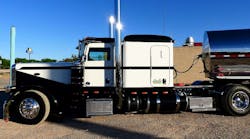The Commercial Vehicle Safety Alliance (CVSA) is reminding all motor carriers and drivers subject to the U.S. Dept. of Transportation’s Federal Motor Carrier Safety Administration (FMCSA) electronic logging device (ELD) final rule that they must use an ELD starting Dec. 17.
This deadline also pertains to grandfathered automatic onboard recording devices (AOBRDs), which will no longer be allowed under the FMCSA regulations to provide records of duty status as a substitute to a required ELD. Motor carriers utilizing an AOBRD must have a fully operational ELD installed by Dec. 17.
According to FMCSA, there will be no extensions or exceptions made to the ELD rule deadline. In addition, CVSA said inspectors will begin fully enforcing the ELD rule on Dec. 17—so there is no “soft enforcement” grace period.
If a commercial motor vehicle driver is required to have an ELD and the vehicle is not equipped with a registered compliant ELD, the driver is considered to have no record of duty status; that also applies to a driver still using an automatic onboard recording device after the AOBRD to ELD transition deadline of Dec. 17. According to the North American Standard Out-of-Service Criteria, a property-carrying driver who does not have a record of duty status in his or her possession when one is required will be declared out of service for 10 hours, and a passenger-carrying driver without a record of duty status when one is required will be placed out of service for eight hours.
CVSA-certified roadside inspectors use the North American Standard Out-of-Service Criteria to identify conditions that preclude further operation of a commercial motor vehicle by its driver for a specified amount of time, or for some conditions, until the violation is corrected. The April 1 North American Standard Out-of-Service Criteria specifies the out-of-service conditions related to deficiencies of record of duty status and hours-of-service rules and regulations. In addition, CVSA’s inspection bulletin regarding hand-held and electronic logging devices outlines the requirements for devices used to record drivers’ hours of service, according to 49 CFR Part 395 Subpart B–Electronic Logging Devices.
FMCSA implemented the ELD rule to make it easier and faster to accurately track, manage and share record of duty status information, and to help improve road safety and reduce the number of crashes. An ELD automatically records a driver’s driving time and other hours-of-service data. Hours-of-service rules and regulations were developed to minimize driver fatigue and improve safety for everyone on the road. In addition, ELDs monitor a vehicle’s engine data, such as when the engine is running, whether the vehicle is moving, miles driven, duration of engine operation, etc.
It’s important to note that the ELD final rule does not change any of the underlying hours-of-service regulations. For more information regarding ELDs, the ELD final rule and hours-of-service, visit FMCSA’s website.



